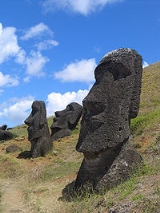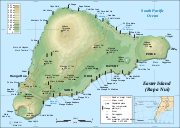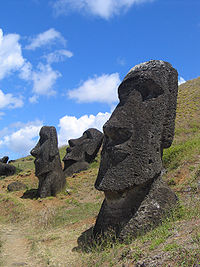
Rapa Nui National Park
Encyclopedia
Rapa Nui National Park is a World Heritage Site
located on Easter Island
, Chile
. The park is divided into seven sections:

 The early history involves human settlement roughly one millennium before present. Subsequent human overpopulation
The early history involves human settlement roughly one millennium before present. Subsequent human overpopulation
and resultant deforestation
led to collapse of the human society. Archaeological evidence of the earlier habitation consists of the moai themselves as well as the pollen and fossil records. Through these records, scientists have come to understand the role of a now extinct Rapa Nui Palm, which offered food, fuel and transport for the early settlers.
Chile first declared the island a National Park
in 1935, and on 22 March 1996 UNESCO
designated the island a World Heritage Site. Park boundaries have since varied on several occasions, to return land to the islanders.
World Heritage Site
A UNESCO World Heritage Site is a place that is listed by the UNESCO as of special cultural or physical significance...
located on Easter Island
Easter Island
Easter Island is a Polynesian island in the southeastern Pacific Ocean, at the southeasternmost point of the Polynesian triangle. A special territory of Chile that was annexed in 1888, Easter Island is famous for its 887 extant monumental statues, called moai, created by the early Rapanui people...
, Chile
Chile
Chile ,officially the Republic of Chile , is a country in South America occupying a long, narrow coastal strip between the Andes mountains to the east and the Pacific Ocean to the west. It borders Peru to the north, Bolivia to the northeast, Argentina to the east, and the Drake Passage in the far...
. The park is divided into seven sections:

- Rano KauRano KauRano Kau is a tall extinct volcano that forms the southwestern headland of Easter Island, a Chilean island in the Pacific Ocean. It was formed of basaltic lava flows in the Pleistocene with its youngest rocks dated at between 150,000 and 210,000 years ago.- The crater :Rano Kau has a crater...
(which includes OrongoOrongo‘Orongo is a stone village and ceremonial centre at the southwestern tip of Rapa Nui . The first half of the ceremonial village's 53 stone masonry houses were investigated and restored in 1974 by American archaeologist William Mulloy...
) - Puna PauPuna PauPuna Pau is a quarry in a small crater or cinder cone on the outskirts of Hanga Roa in the south west of Easter Island...
(named after the quarry where the pukao were carved). - Rano RarakuRano RarakuRano Raraku is a volcanic crater formed of consolidated volcanic ash, or tuff, and located on the lower slopes of Terevaka in the Rapa Nui National Park on Easter Island. It was a quarry for about 500 years until the early eighteenth century, and supplied the stone from which about 95% of the...
(named after the quarry where most of the moaiMoaiMoai , or mo‘ai, are monolithic human figures carved from rock on the Chilean Polynesian island of Easter Island between the years 1250 and 1500. Nearly half are still at Rano Raraku, the main moai quarry, but hundreds were transported from there and set on stone platforms called ahu around the...
were carved). - AnakenaAnakenaAnakena is a white coral sand beach in Rapa Nui National Park on Rapa Nui , a Chilean island in the Pacific Ocean. Anakena has two ahus, one with a single moai and the other with six...
- Ovahe - Ahu AkiviAhu AkiviAhu Akivi is an ahu with seven moai on Rapa Nui in Chilean Polynesia. The ahu and its moai were restored in 1960 by the American archaeologist William Mulloy and his Chilean colleague, Gonzalo Figueroa García-Huidobro...
- Costa Norte
- Hanga RoaHanga RoaHanga Roa is the main town, harbour and capital of the Chilean province of Easter Island. It is located in the southern part of the island's west coast, in the lowlands between the extinct volcanoes of Terevaka and Rano Kau....
(Urban Area).
History

Overpopulation
Overpopulation is a condition where an organism's numbers exceed the carrying capacity of its habitat. The term often refers to the relationship between the human population and its environment, the Earth...
and resultant deforestation
Deforestation
Deforestation is the removal of a forest or stand of trees where the land is thereafter converted to a nonforest use. Examples of deforestation include conversion of forestland to farms, ranches, or urban use....
led to collapse of the human society. Archaeological evidence of the earlier habitation consists of the moai themselves as well as the pollen and fossil records. Through these records, scientists have come to understand the role of a now extinct Rapa Nui Palm, which offered food, fuel and transport for the early settlers.
Chile first declared the island a National Park
National park
A national park is a reserve of natural, semi-natural, or developed land that a sovereign state declares or owns. Although individual nations designate their own national parks differently A national park is a reserve of natural, semi-natural, or developed land that a sovereign state declares or...
in 1935, and on 22 March 1996 UNESCO
UNESCO
The United Nations Educational, Scientific and Cultural Organization is a specialized agency of the United Nations...
designated the island a World Heritage Site. Park boundaries have since varied on several occasions, to return land to the islanders.

